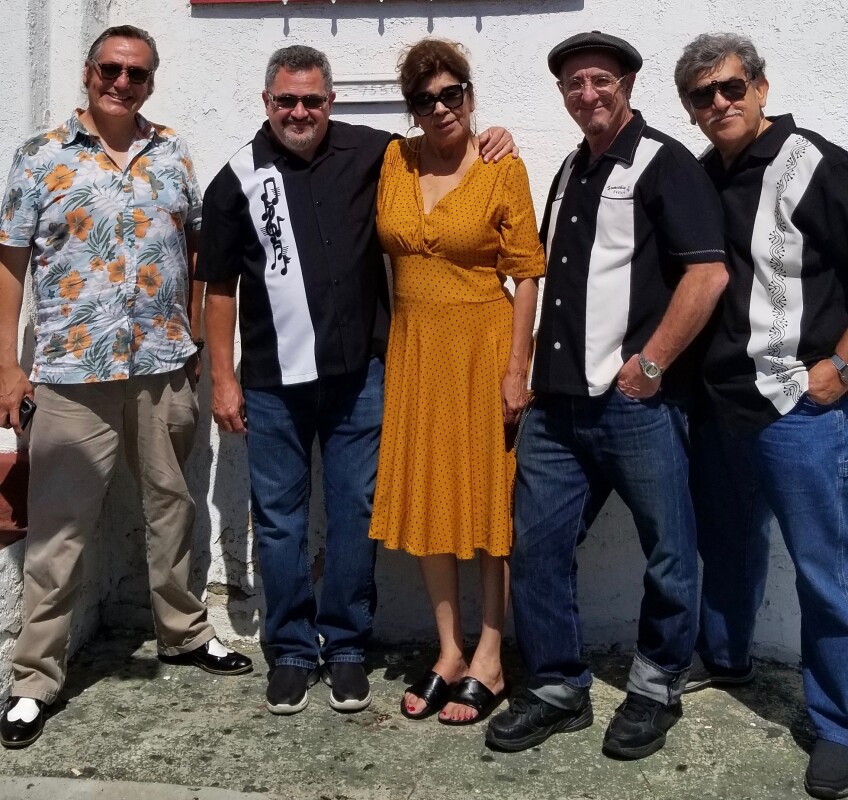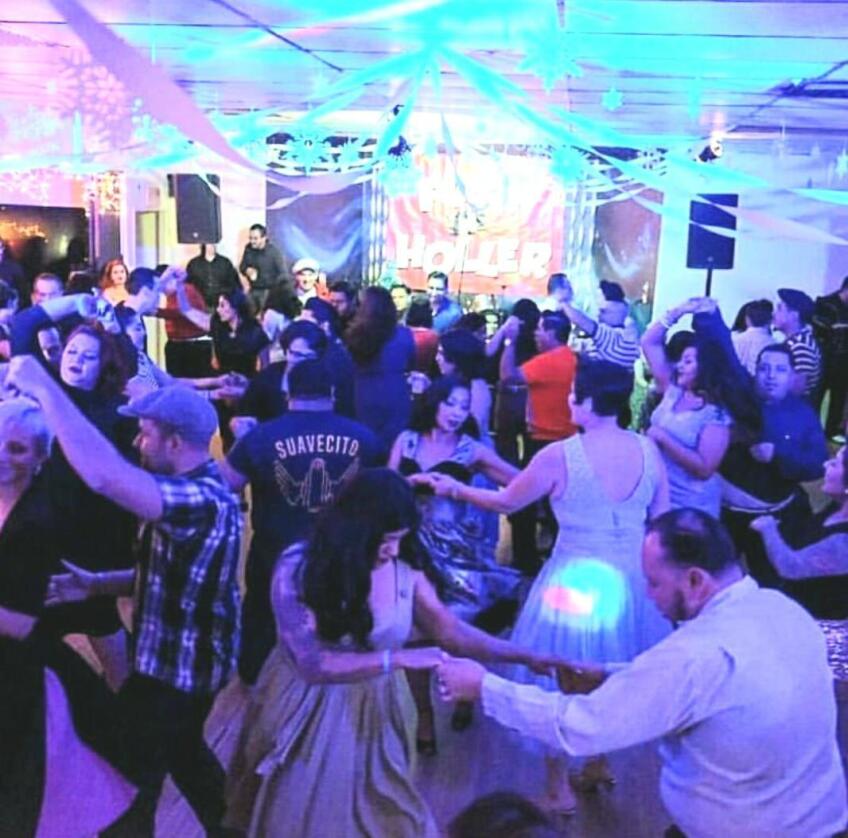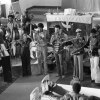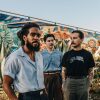
In Bell Gardens, American Legion Hall Post #465 Is an Unlikely Musical Mecca
“The Vets are first and foremost; the reason for this Hall,” says Rita Sykes (nee Armas). Her hair is perfectly swept up in a swirl of mocha brown, smooth and floating above her face. She holds the keys to the joint, literally. If you want to play at the American Legion Hall Post #465 in Bell Gardens, you have to demonstrate trustworthiness and good manners, or else your band's not getting in.
When you drive by 7550 Eastern Avenue in Bell Gardens, you may not recognize the one-story building as the historic musical venue it is. You may not see it at all. When I passed the building throughout my childhood, the shape of it made me think of church and I was right: in the 1920s it was a Baptist church. But since 1946 when it received its charter, the one-story casita has been the Clyde F. Hager American Legion Hall Post #465. Its original hardwood floors were there when Eddie Cochran became the artist who wrote the song "Summertime Blues." He lived down the street on Priory and on Gage Avenue too. Revelers from all backgrounds have danced at the Hall to legendary Wanda Jackson. They've screamed lyrics back to iconic punk band The Zeros. Most recently, they bopped and strolled at the rockabilly party Fuss 'n' Holler and to songs by and the Crown City Bombers.

It sits unassumingly next to the Foster’s Freeze ice cream parlor, which middle-schoolers from around the block visit for the soft serve. The faces in the shop are those of mostly Latinx young people and families, but the American Legion Hall next door has a crowd that spans across generations, racial and ethnic backgrounds, meeting on the original hardwood floors and at the bar telling stories, most importantly, to gathering together. This is especially true for rockabilly shows and occasionally punk shows too.
This is a normal thing for Bell Gardens. The love for the space is spread far and wide. I got to meet Robert Gerard, Roberto Fernandez (who are brothers), Max Espinoza and Rafael Navarro (an Emmy-award winning illustrator), all of whom are co-founders of the Cochran Club, a dance party that began as a fundraiser in 2010 to save the Post from financial ruin. They have re-formed themselves as the current Cochran Club, now making a documentary about the Post and Eddie's historic presence there. Ruben had on gold-rimmed glasses and wool cap, classic vintage apparel.

Gerard said it’s important for them to support the Hall because it is:
"... a part of their own personal history and pride. Growing up here there were things we weren't happy about: there was a lot of fighting, a lot of struggle going on. But there were a lot of good things going on too and this place reminds us of some of the good things that went on in Bell Gardens."
I could spend more time telling you about Cochran and his life, how he was friends with Ritchie Valens who played at other Legion Halls in the Valley, but what I was amazed by was these folks I sat with at the Formica table. Fernandez and a friend extended the stage so musicians could actually stand on it. His wife Gabby painted the starry sky mural on the stage. Their relatives fought on the beaches of Normandy and in Vietnam. One of them made the plaster cast of the plaque that sits surely in the middle of the famed photo wall. Navarro and I had the same middle school teacher, Mrs. Feito, who made us sing show tunes at Suva Intermediate. What we have in common is that we love this land the Hall was built on. The Hall and the music make it possible for us to connect.

And the party continues with the widely-loved part, Fuss 'n' Holler. Going now for about five years, Satoshi and Lori Tsukamoto are the promoters of this rockabilly party, which a few days ago saw 200 plus people pack the Hall. Lori noted that people loved the venue because it's welcoming and not "too frilly." They both agreed that the music and the scene make up the heart of their lives. Satoshi, also known as DJ Satoshi, noted that rock and roll shaped his life a young person in Japan. "I have no idea what kind of kid I was gonna be if I didn't meet this kind of music; it changed my life." Photos from Fuss 'n' Holler this month showed a night packed with parejas, friends and folks ready to get out on the floor and dance their hearts out.

Remember that the parties at the Hall vary in genre. In this video taken by artist Shizu Saldamando, her friend Joe sings back to The Zeros. The reverb is so thick that the words blur. Only if you were there (literally or figuratively) will you ever know what it was like: the green and red lights twirling on the drop ceiling, fists pumping with every sentence. The driving guitar, loudest of the loud, a sea of black T-shirts and jackets, rage mixed with delight. Piles of plastic vodka bottles wrapped in Christmas lights; the sweat hanging in the air. All of it spells relief, a kind of reverie and worship. Whatever rage crests inside, it is on the dance floor as the pogo, a pit. The hardwood is soft under their feet. This too is the Hall, the Bell Gardens of the last 40 years, the one we're living in now.

Punk enthusiast Joseph Calderon, born and raised in the City of Commerce and East Los Angeles described this place in this way:
“If someone didn't grow up in the little niche-like area that we did, it's kind of hard to explain to them [what this area is like] [...]. People think of L.A. and they think about downtown, Hollywood, they think Silver Lake and it's like, L.A. goes a little a bit farther out that way. The surrounding suburbs around L.A. have always had a really vibrant scene of subculture music.”
Calderon has attended numerous punk shows at the Hall and dozens of backyards shows in Bell Gardens throughout his life. He said the connection between Cochran-era rock and roll and punk is easy to see: "The guitar translates." He pointed to a cover of the Eddie Cochran song, "Something Else" by Sid Vicious. When I met members from the Sons of the American Legion at the Hall, one of them mentioned that Led Zeppelin also did a cover of the song. The intersections of generations are all over the Hall because music is the vehicle that gets us all there.
Saldamando remembers the night of that show. People of all ages were there, "Younger kids and older dudes. Legion Halls are always weird because you have the two separate kinds of crowds: The older folks at the bar, and whatever crowd has shown up for the shows." Legions appear to be nondescript, she noted, which is a description that the tracks for Post #465.
After the show she remembers "a bunch of drunk people hanging outside or passed out on the stairs. It wasn't sad," Saldamando laughed, "It was funny." She recalls the penchant this country has for nostalgia.
People were into the 1950s in the '80s. In the '90s, the 1960s came back around. And now the '90s are popular. It's a rite of passage for the younger generation to emulate the cultures of their parents and grandparents.
The pace is as intergenerational as it gets. Sykes has been booking gigs here and telling stories with veterans at the bar since 2011 but her husband Ronald was a member of the post for 30 years before he died in 2010. She was a member of the Women's Auxiliary group during that time and even worked at George's Playroom, another bar I passed as a kid walking with my brothers. Born and raised in East Los Angeles, Sykes is discerning, glamorous and as she likes to say, "strong-willed." She loves supporting younger female lead bands too, like June Clivas and the Ditty Boys and Little Sue and the Cow Tippers who donated the raffle money to the Hall from a recent gig with the Crown City Bombers. Lil Sue who's from the Inland Empire said that the one thing she can say about music is that "it brings people from all walks of life together. Places like [the Hall] are legendary! Just walkin' in you can feel the vibe of every musician that has played there… every twirl made on the dance floor, and the joy felt by all of us! It's infectious!"
Coming together around music is important as the Legion has a mostly white membership (in a very Latinx region) and a total of about 60 members at the moment. In normal times, when the group is up and running, they organize various community service programs for and with veterans. In the past, the post has adopted schools to help them with different projects and supported local families at holiday time by providing them with baskets and gifts. They have also worked with the VA hospital and retirement homes. Because of the pandemic, the Hall is just now bouncing back from a long hiatus. While they weren't present the day I visited Gerard, a member of the Sons of the Legion, assures me that they vets enjoy the music the Hall hosts, especially the rockabilly gigs.
Things were rough last year, like it was for so many other music venues. Sykes, with the help of her granddaughter and Lori Tsukemoto (from Fuss and Holler), started a GoFundMe campaign to help pay for bills when the hall was facing Financial challenges this past year. However, because of a technical error, GoFundMe has not released the funds to them.
When I asked Skyes about the future of the Hall she said she's hopeful. She's lowered the price to rent the hall to $600 so that local families who are largely working class can have access to the space and host weddings and quinceañeras.
The Hall welcomes all.
The first thing you see when you walk in is the bar, a long dark wood counter (or is it particle board?) and its red cushions for folks to lean on. In the Hall, we are rock and roll-adjacent: Eddie, Ritchie, me and you, borrowing it from its library of the origin, the blues and Big Momma Thornton's guitar.
We worship the chords, the notes and dance on Eastern Avenue. Down the street from George's playroom where Rita wiped whiskey and tears. The Hall is still a humble house, a new house of worship where we praise the stories in our songs.
Sources
"Memories of the Skin: Shizu Saldamando's Portraits," Raquel Gutiérrez, August 17, 2018, https://lareviewofbooks.org/article/memories-of-the-skin-shizu-saldamandos-portraits/
"Eddie Cochran historic site - American Legion Hall in Bell Gardens, California," Video created and narration by Antoon van Olderen, circa 2013, https://www.youtube.com/watch?v=4JVqi7-_2ko












